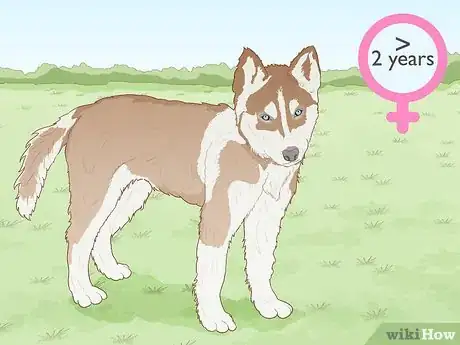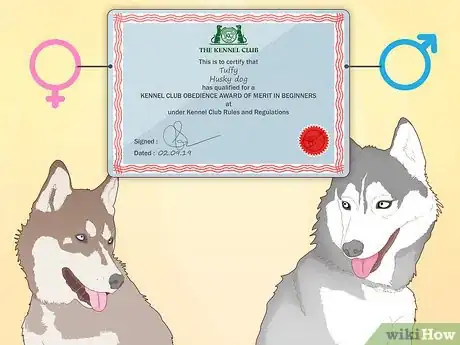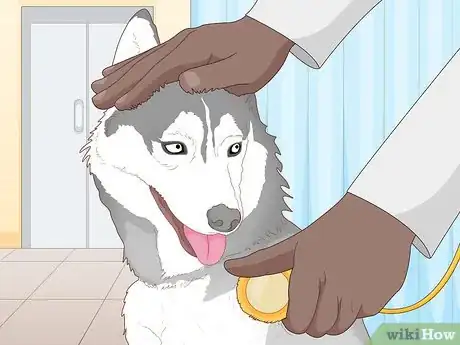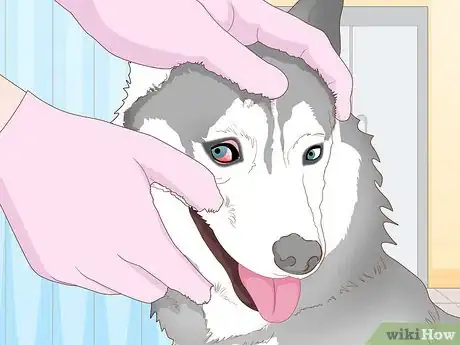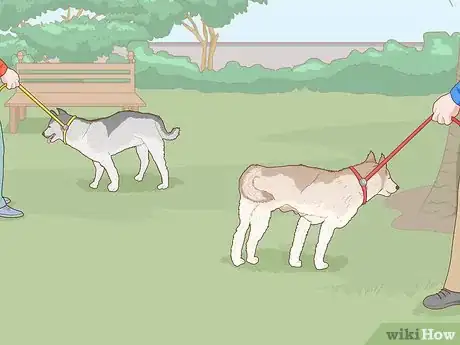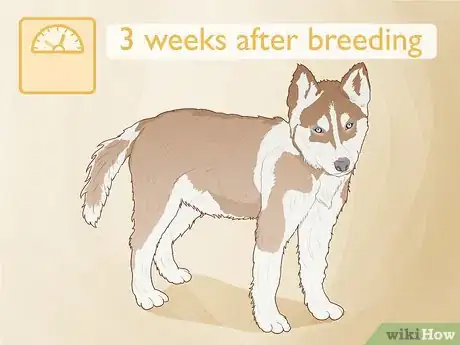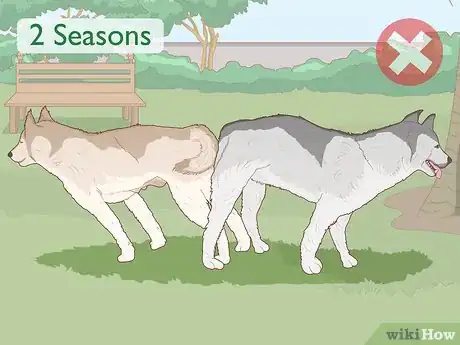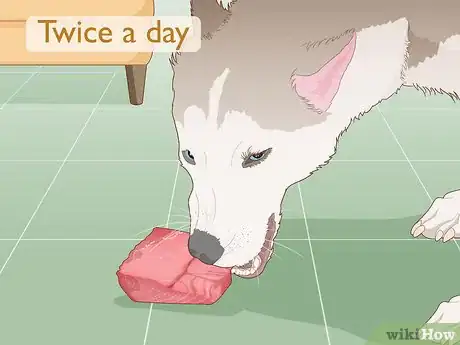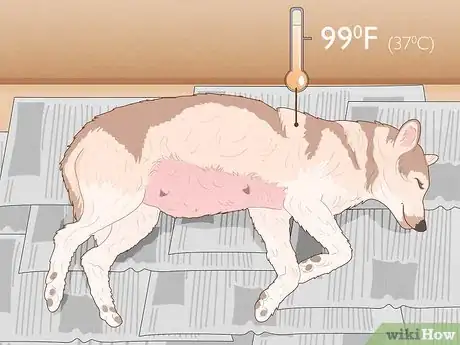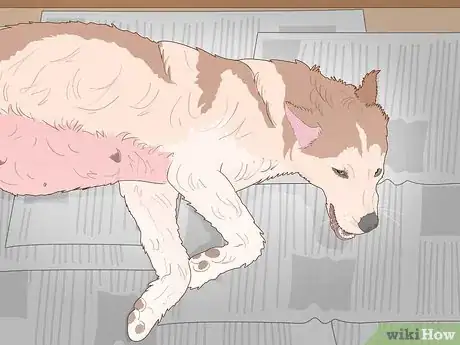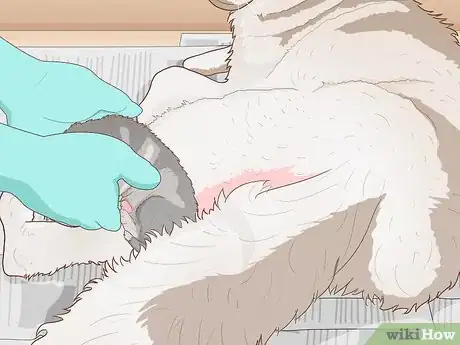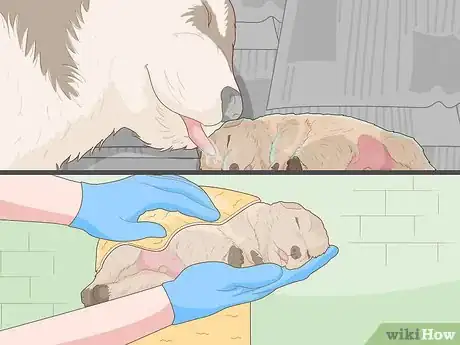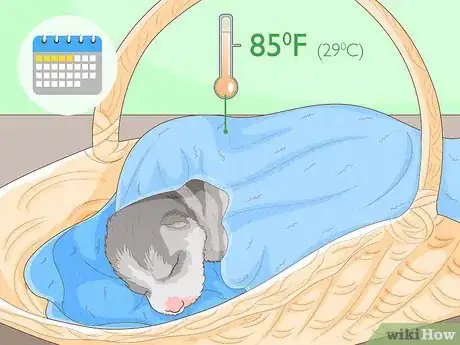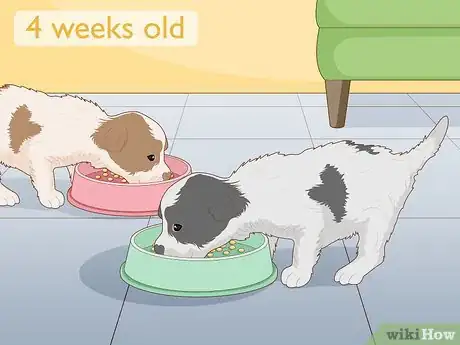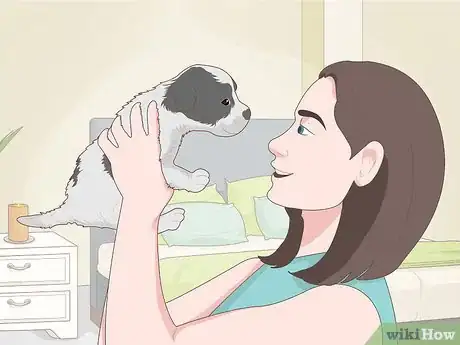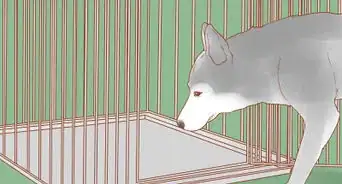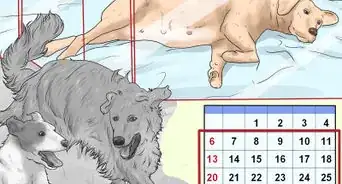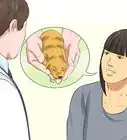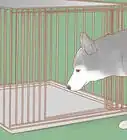This article was co-authored by Beverly Ulbrich and by wikiHow staff writer, Amber Crain. Beverly Ulbrich is a Dog Behaviorist and Trainer and the Founder of The Pooch Coach, a private dog training business based in the San Francisco Bay Area. She is a Certified CGC (Canine Good Citizen) Evaluator by the American Kennel Club and has served on the Board of Directors for the American Humane Association and Rocket Dog Rescue. She has been voted the best private dog trainer in the San Francisco Bay Area 4 times by SF Chronicle and by Bay Woof, and she has won 4 "Top Dog Blog" awards. She has also been featured on TV as a dog behavior expert. Beverly has over 18 years of dog behavior training experience and specializes in dog aggression and anxiety training. She has a Master of Business Administration from Santa Clara University and a BS from Rutgers University.
There are 10 references cited in this article, which can be found at the bottom of the page.
wikiHow marks an article as reader-approved once it receives enough positive feedback. In this case, 100% of readers who voted found the article helpful, earning it our reader-approved status.
This article has been viewed 137,820 times.
Siberian huskies are known for being compassionate, hardworking, and intelligent dogs. Breeding huskies involves finding healthy dogs who are registered with a kennel club, determining when the female is fertile, caring for the female during and after pregnancy, and caring for the husky pups. As with any dog, breeding huskies is a serious undertaking and should not be taken lightly.
Steps
Choosing Suitable Huskies to Breed
-
1Wait until the female is 2 years old. Larger female dogs take a bit longer than males to mature. Female huskies aren't ready to breed until they are 2 years old or older. Don't breed her until she has her second heat cycle. She'll probably have her first heat cycle at 5 to 7 months, but her body isn't mature enough for breeding at that time.[1]
- Male dogs are mature after about 6 months.
-
2Breed females with a calm and nurturing temperament. The stud dog only needs to perform one job (getting the dog pregnant), but the dog must carry the puppies to term and care for them when they are young. A calm female dog is more likely to be a good mother to the pups.[2]
- Using a female with an aggressive temperament can result in unhealthy or aggressive puppies.
Advertisement -
3Make sure both dogs are registered with a kennel club. If maintaining a pure husky bloodline is important to you, both dogs should be registered with the American Kennel Club (AKC), the Continental Kennel Club (CKC) or the United Kennel Club (UKC).[3]
- Both dogs need to be registered with the same club in order for the puppies to be eligible for registration.
- Only purebred dogs can be registered with the AKC.
- Research the bloodlines of both dogs to learn about potential health problems or temperament issues. Try running a Google search using key words like "husky bloodlines" and "breeding husky bloodlines." You can also visit http://siberian-husky-bloodlines.seppalasleddogs.com/index.htm.
-
4Have a vet perform a physical on both dogs 4 weeks before breeding. Both dogs should have a thorough veterinary check-up about a month before breeding begins. Get them up-to-date on vaccinations and make sure they're free from parasites. Have them screened for brucellosis, which is a disease that can cause infertility.[4]
- It's also a good idea to ask the vet to screen both dogs for evidence of hip dysplasia.
- The bitch should have good muscle tone and should not be overweight.
-
5Have both dogs' eyes checked by a canine ophthalmologist. Genetic disorders of the eyes are common in huskies. These disorders can appear at any age, so it is important to have your dogs' eyes checked once a year. Have a screening performed on both dogs prior to breeding.[5]
Mating the Huskies at the Right Time
-
1Recognize when the female dog goes into heat. Look for signs of proestrus, or the first period of your dog’s heat cycle. During proestrus, your dog may bleed and her vulva may become swollen, but she will not accept a mate. After around 9 days, you dog will move into the second period of her heat cycle, known as estrus. During estrus—which also lasts about 9 days—your dog will be fertile.[6]
- If you think your dog might be in heat but you are not sure, bring the dog in to see the vet.
-
2Mate the dogs after the female enters the estrus portion of her cycle. The most fertile time for dogs is usually between the 10th and 14th day after the beginning of her heat cycle (proestrus). You can bring the dogs together for mating every other day until they have mated 2 or 3 times total.[7]
- The ideal mating window lasts about 5-9 days.
- Females are generally more comfortable in new environments than males. For this reason, the dog is usually brought to the stud.
-
3Keep her away from other male dogs after mating her. If allowed to be around other male dogs, she may become pregnant with their puppies instead. After mating her with your chosen male, keep her in a restricted area away from all other male dogs.
-
4Take her to the vet once she begins showing signs of pregnancy. Signs of pregnancy in your husky can include increased appetite, weight gain, and enlarged nipples. You may be able to spot them as early as 3 weeks after breeding. After about 28 days, you can bring your dog to the vet to have the pregnancy confirmed. Your vet will use ultrasound, palpitations, or X-rays to diagnose a pregnancy.
- Sometimes dogs will show these symptoms when they are not pregnant.
-
5Wait a full season after pregnancy before breeding the female again. Female huskies should not be bred in 2 consecutive seasons. Even if the pregnancy was not viable, wait a full heat season before trying to breed her again. A heat season usually comes about every 6 months, although it may be delayed following a pregnancy.[8]
- Pregnancy is difficult on your dog’s body. For her own safety and the safety of future puppies, she needs time to recover.
Caring for a Pregnant Female
-
1Feed your pregnant dog nutritious food at least twice daily. A healthy bitch can continue to eat a normal diet during the first part of her pregnancy. As her body weight increases, her food intake can be increased gradually. Keep her food intake the same for the 5 to 6 weeks of pregnancy. After the sixth week, slowly increase her food intake. By the time she's ready to birth, she should be eating 35-50% more food that usual.[9]
- Feed her at least twice daily -- morning and night. It's better to feed her 3 times a day -- morning, noon, and evening.[10]
- Some breeders recommend adding an additional protein source to your pregnant dog’s diet, such as evaporated milk, eggs, meat, or liver.
- Providing small, frequent meals can help your pregnant dog feel more comfortable.
-
2Prepare a whelping box. Choose a place that is warm, dry, quiet, and separate from other dogs. Create a roomy box that has low sides. Bring her into the box every day so that she gets used to the area. Pet her and make sure time spent in the box is a positive experience for her.[11]
- Create a whelping box well in advance, so that your dog has time to get used to it.
- You can purchase a whelping box, build one from wood, or repurpose a large plastic container.
-
3Prepare for the arrival of the puppies after 63 days of pregnancy. Husky gestation lasts about 63 days. When the arrival of the puppies is getting close, gather some supplies.[13] Some things you may need include:
- Newspaper for bedding
- Bath mats or towels for bedding
- Towels for cleaning the puppies
- Paper towels for cleaning the whelping box
- Thermometer to check the bitch’s temperature
- Heating pad to keep puppies warm
- Dental floss (unwaxed) for tying the puppies umbilical cords
- Sharp scissors to cut the umbilical cord
- Iodine to clean the umbilical cord.
-
4Line the box with newspaper right before she gives birth. At the time of the birth, you may want to line the box with newspapers so that it can be changed several times a day. After a few days, you can switch to towels or other soft materials. These will still need to be changed about once a day.
-
5Watch for the first signs of labor. A few days before she is ready to give birth, your bitch may stop eating and start creating a "nest." About 1 day prior to giving birth, your bitch’s body temperature should drop to around 99 °F (37 °C). During the first stage of labor, her cervix will dilate. Contractions will begin and she may whine and appear distressed or confused. You might notice her panting, straining, or moving around restlessly.
- This stage usually lasts 6 to 18 hours.
- Ideally, your dog will build her birthing nest in the whelping box you provided.
-
6Watch for her water to break and full labor to begin. When her water breaks, this signals the second and final stage of her labor. The water looks like straw-colored liquid. Her contractions will get more intense after this and she'll go into labor very soon after her water breaks. Puppies will appear sporadically every thirty minutes or so once full labor begins.[13]
- Labor typically lasts about 4 hours.
- Most dogs will give birth easily without the need of human help.
-
7Know when to contact a vet. In most cases, mother dogs will give birth all on their own without much assistance. However, make sure you have your veterinarian's phone number and the number for local emergency animal clinic ready in case of emergency.[14] Contact your vet if:
- The mother appears to be in extreme pain.
- The mother has powerful contractions for more than 45 minutes without the birth of a pup.
- More than two hours pass between the delivery of puppies.
- The mother dog is trembling or shivering.
- The mother dog collapses.
- A dark green or bloody fluid comes out before the birth of the first puppy. (After the first puppy, this is OK.)
- The mother shows no signs of labor 64 or more days after mating.
Caring for Newborn Puppies
-
1Make sure the mother is licking and cleaning each newborn pup. The mother dog should remove the membrane from its face so the pup can breathe, chew the umbilical cord, and lick each puppy to stimulate its breathing. If she neglects to do any of these things, you may need to intervene.[15]
- Tear the sac membrane near the puppy's head, peel it backwards, and remove the puppy.
- Use a washcloth to remove mucus from the puppy's mouth and nose. Then rub the puppy all over to stimulate breathing.
- Tie the umbilical cord using unwaxed dental floss. Use sharp scissors to cut the cord about 2 inches (5.1 cm) away from the abdomen on the far side of the knot. Treat the cut with iodine to prevent infection.
-
2Let the puppies nurse as soon as they're born. This is crucial for the puppies because it allows them to ingest colostrum (or newborn milk) with important antibodies. Colostrum helps the puppies fight infection while their immune systems continue to develop.[16]
- It a good idea to weigh the puppies after birth and then every other day for the first 2 weeks. They should gain a little weight with every weigh-in.
-
3Keep the puppies warm. Newborn puppies are not able to maintain their own body temperature. For the first 5 days, keep the whelping area between 85 °F (29 °C) and 90 °F (32 °C). For the next 5 days, you can reduce the temperature to 80 °F (27 °C). After 4 weeks, you can bring the temperature down to 75 °F (24 °C).[17]
-
4Make sure the puppies eat every 2 hours for the first week. After the first week, growth will start increasing rapidly and they may need to eat even more frequently -- possibly every hour or so. This is totally normal and a good sign they're developing well. Start transitioning the puppies to solid food after 4 weeks.
-
5Find good homes for the puppies. People sometimes purchase puppies without realizing how much care, attention, and time they need. Ensure that a new owner will treat your puppy properly before handing over the dog.[18]
- Interview potential puppy-owners to find about their lifestyle, and whether or not they seem up to the responsibility of raising a husky.
- Perform a home visit to make sure they have a suitable space.
- Get their driver’s license number and do a background check to make sure they no have a history of animal neglect or abuse.
Community Q&A
-
QuestionAre huskies a good family dog?
 wikiHow Staff EditorThis answer was written by one of our trained team of researchers who validated it for accuracy and comprehensiveness.
wikiHow Staff EditorThis answer was written by one of our trained team of researchers who validated it for accuracy and comprehensiveness.
Staff Answer wikiHow Staff EditorStaff AnswerThey can be with proper training. Huskies are very friendly and sociable. However, keep in mind that they are very high-energy, so they need a lot of play and exercise to keep them from becoming destructive. They also have a strong prey drive, so you must keep a close eye on them around other family pets.
wikiHow Staff EditorStaff AnswerThey can be with proper training. Huskies are very friendly and sociable. However, keep in mind that they are very high-energy, so they need a lot of play and exercise to keep them from becoming destructive. They also have a strong prey drive, so you must keep a close eye on them around other family pets. -
QuestionHow many puppies can a dog have in her first litter?
 wikiHow Staff EditorThis answer was written by one of our trained team of researchers who validated it for accuracy and comprehensiveness.
wikiHow Staff EditorThis answer was written by one of our trained team of researchers who validated it for accuracy and comprehensiveness.
Staff Answer wikiHow Staff EditorStaff AnswerAn average litter size for dogs is about 5 puppies. However, your dog may have a smaller litter the first time she gets pregnant. Litter size is highly variable, so there’s no sure way to predict how many puppies she’ll have.
wikiHow Staff EditorStaff AnswerAn average litter size for dogs is about 5 puppies. However, your dog may have a smaller litter the first time she gets pregnant. Litter size is highly variable, so there’s no sure way to predict how many puppies she’ll have. -
QuestionDo huskies shed a lot?
 wikiHow Staff EditorThis answer was written by one of our trained team of researchers who validated it for accuracy and comprehensiveness.
wikiHow Staff EditorThis answer was written by one of our trained team of researchers who validated it for accuracy and comprehensiveness.
Staff Answer wikiHow Staff EditorStaff AnswerYes, they do! Huskies will go through a major shed twice a year, when they blow their undercoat during the changing of seasons. You’ll need to brush your dog regularly to keep the shed hair under control.
wikiHow Staff EditorStaff AnswerYes, they do! Huskies will go through a major shed twice a year, when they blow their undercoat during the changing of seasons. You’ll need to brush your dog regularly to keep the shed hair under control.
References
- ↑ http://www.akc.org/dog-breeders/responsible-breeding/#health
- ↑ http://www.akc.org/dog-breeders/responsible-breeding/#health
- ↑ https://www.cuteness.com/article/breed-siberian-husky
- ↑ http://www.shca.org/shcahp4b.htm
- ↑ http://www.shca.org/shcahp4b.htm
- ↑ http://www.akc.org/dog-breeders/responsible-breeding/#health
- ↑ http://www.akc.org/dog-breeders/responsible-breeding/#health
- ↑ http://www.shca.org/shcahp4b.htm
- ↑ https://www.vetwest.com.au/pet-library/breeding-what-to-expect-after-mating
- ↑ http://www.akc.org/content/dog-breeding/articles/the-care-and-feeding-of-the-breeding-bitch-part-one/
- ↑ http://www.akc.org/dog-breeders/responsible-breeding/#health
- ↑ Reproduction in the Dog and Cats. Christiansen. Publisher Bailliere Tindall.
- ↑ http://www.2ndchance.info/caninelaborstages.htm
- ↑ http://www.akc.org/dog-breeders/responsible-breeding/#puppies
- ↑ http://www.akc.org/dog-breeders/responsible-breeding/#born
- ↑ http://www.akc.org/dog-breeders/responsible-breeding/#born
- ↑ http://www.akc.org/dog-breeders/responsible-breeding/#puppies
- ↑ https://www.petfinder.com/pet-care/giving-up-your-pet/tips-finding-home-pet/
About This Article
To breed husky dogs, you'll need a female husky that's at least 2 years old and a male husky that's at least 6 months old. Before you breed the dogs, have them examined by a vet to make sure they don't have any diseases or health problems that could affect the pregnancy. Then, breed them when the female husky is in heat. After they mate and you've confirmed that the female is pregnant, prepare to wait about 63 days for the puppies to be born. To learn how to take care of a pregnant husky, scroll down!
